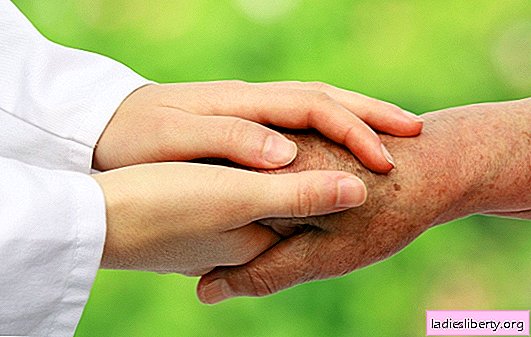
Erysipelas or erysipelas is a fairly common infectious skin disease that is often chronic.
Consider in more detail the symptoms of erysipelas of the hand and the main methods of treatment for this condition.
Erysipelas of the hand: causes of the disease
Most often, erysipelas develops for the following reasons:
1. The defeat of streptococci. They are spherical bacteria that tolerate heat well, and therefore are considered very tenacious. Moreover, if streptococcus enters the body with a weak immune system, then a person can develop diseases such as tonsillitis, rheumatism and myocarditis.
If streptococcus enters the body with a fairly strong immune state, then a person can become a carrier of this bacterium.
You can catch erysipelas from any form of streptococcus, which is transmitted through poorly washed hands or household items.
Once in the body, streptococci begin to negatively affect it, namely:
• dissolve healthy cells;
• provoke inflammation;
• lower immunity;
• cause fragility of blood vessels;
• adversely affect the joints.
2. Various skin lesions can also cause erysipelas of the hand. Typically, such damage includes:
• cuts with sharp objects;
• bruise;
• injection site;
• abrasions.
Moreover, if there is even slight damage on the skin, then it will become susceptible to streptococci. These bacteria will penetrate the layers of the skin and poison the body.
3. Skin contact with various chemicals.
4. Wearing rubber.
5. Herpes.
6. Chicken pox.
7. Deprive.
8. Psoriasis.
9. Dermatosis.
10. Dermatitis.
11. The boil.
12. Thrombophlebitis.
13. The presence of postoperative scars.
14. Various fungal diseases.
Symptoms and signs of erysipelas of the hand
The following symptoms of erysipelas of the hand are distinguished:
1. Pain in the hand, which has a clear localization (at the site of the lesion it is most pronounced).
2. Weakness.
3. Body aches.
4. Pain in the head.
5. Disability.
6. Chills.
7. An increase in body temperature.
8. Loss of appetite.
9. Convulsions (rarely).
10. Nausea.
11. Redness of the skin on the arm is observed approximately one day after the onset of the disease. In this case, the affected arm can turn bright red. This symptom disappears only on the 10-14th day with proper treatment.
12. The appearance of peeling at the site of redness.
13. The appearance of a dense roller on the skin.
14. The focus of inflammation itself will have uneven edges.
15. Feeling of fullness on the skin.
16. Burning.
In severe cases, a person with erysipelas will suffer from the following symptoms:
1. Hemorrhages develop when the capillaries are damaged.
2. The appearance of water bubbles on the skin.
3. The appearance of vesicles on the skin filled with pus.
It is important to know, that sometimes erysipelas are easily confused with ordinary dermatitis. This is especially true for young children. For this reason, you can not delay the trip to the doctor even when the first symptoms appear.
Erysipelas of the hand: treatment and diagnosis
If you suspect a erysipelas, you should contact a dermatologist. After the initial examination, he will prescribe such studies:
1. General blood test.
2. A bacteriological study to determine the pathogen of infection.
Treatment for erysipelas should be comprehensive. It includes the following:
• increase the immunity of the patient;
• drug treatment;
• external treatment of affected skin;
• hygiene rules;
• physiotherapy.
First of all, with erysipelatous inflammation of the hand, it is necessary to increase immunity. For this, the patient should eat such foods:
1. Drink mineral water. It will help remove toxins from the body and reduce the severity of symptoms. At least two liters of such water should be drunk per day.
2. Eat easily digestible proteins (boiled fish, boiled meat, seafood, cheese).
3. Eat fats. They will help the skin recover faster. Such healthy fats are found in large quantities in walnuts, sea fish and oils (olive, sunflower, flaxseed).
4. Eat vegetables and fruits, especially carrots, currants, apples and pumpkins. They are rich in potassium, iron and other vitamins that are so needed to improve the functioning of the immune system.
5. In large quantities, you can eat low-fat sour-milk products (kefir, cottage cheese, fermented baked milk). They are needed to normalize microflora, which can go astray during antibiotic treatment.
It is better to refuse the use of the following products so as not to provoke even greater inflammation in the body:
1. Fats of animal origin.
2. Coffee.
3. Chocolate and other sweets should not be eaten at all with erysipelas, as they provoke the development of dangerous bacteria.
4. Bread and bakery products.
5. Smoked meats.
6. Sausages.
7. Spicy sauces.
You also need to have a healthy sleep and give up bad habits (smoking, drinking alcohol).
Drug treatment of erysipelas involves the use of such groups of drugs:
1. Antibiotics of the penicillin group (Benzylpenicillin).
2. Antibiotics of the tetracycline group (Doxycycline).
3. Antibiotics of the chloramphenicol group (chloramphenicol).
4. Antiallergic drugs (Suprastin, Tavegil, Diazolin).
5. Sulfanilamides (Streptocide).
6. Drugs to slow the growth of bacteria (Furadonin).
7. Multivitamins.
Local treatment of erysipelas involves the following:
1. Applying compresses with Dimexidum solution. To do this, a gauze sterile napkin needs to be wet in the solution and applied to the affected skin so that it still captures 3 cm and healthy skin. The procedure must be repeated twice a day.
2. Sprinkle the skin with antifungal powders. They will eliminate bacteria on the affected skin and prevent the development of other microbes.
3. Use compresses with Microcide solution. To do this, the gauze dressing needs to be wet in the solution and applied to a sore spot for several hours.
4. Treat the skin with antibacterial aerosol twice a day.
It is important to know, that with erysipelatous inflammation of the skin, you can not use Vishnevsky ointment or syntomycin ointment, since they only enhance inflammation.
It is also not advisable to independently use traditional medicine, as they often do more harm than good (provoke the spread of inflammation).
Due to the fact that erysipelas is not contagious, the patient does not pose a danger to others and with a stable course of the disease can be treated at home. At the same time, he must follow these recommendations for personal hygiene:
1. Every day, change bedding, which must be washed at a temperature of at least 90 degrees and ironed.
2. Every day to change underwear.
3. Wear clothing such that it does not cover the affected area of the arm.
4. Clothing should be made from natural fabrics.
5. Take a shower daily without using a washcloth. If this rule is not followed, then other infections can join the affected skin.
6. Do not wipe the skin with a normal towel after a shower. It is better to soak moisture with a paper towel.
7. Every day you need to wash the affected skin with a decoction of chamomile, which will relieve inflammation.
8. Even when the skin is almost completely healed, it can be treated with Kalanchoe juice. He will remove the peeling.
In addition, with prolonged erysipelas, the patient may be prescribed such physiotherapeutic procedures:
1. The effect of ultraviolet rays on the affected skin until redness appears. The general course of such treatment should be from 4 to 12 sessions.
2. Electrophoresis with the addition of potassium. This procedure will have a good effect on the outflow of lymph and reduce infiltration. The course of treatment should include at least ten sessions.
3. UHF therapy is prescribed to improve blood circulation and relieve inflammation. It also needs to be carried out in 10 sessions.
4. Conducting magnetotherapy will help the body produce steroid hormones. These substances will inhibit inflammation and relieve swelling.
5. Infrared laser therapy will strengthen the immune system, improve tissue nutrition and blood circulation. It will also relieve pain, swelling. Such a procedure is prescribed already in the patient's recovery period.
6. Applying with paraffin will improve the nutrition of tissues and will contribute to their final healing.
Erysipelas of the hand: treatment, complications, prevention
In the absence of timely treatment of erysipelas, it can cause such complications:
1. Necrosis of the skin.
2. Phlebitis.
3. Purulent skin lesions.
4. Sepsis.
5. Abscess of the skin.
6. The development of acute heart failure.
7. Impaired renal function.
8. Profuse lesion of streptococcus skin.
In order to prevent the appearance of erysipelas on the arm and other parts of the body, you should adhere to such recommendations:
1. Observe personal hygiene (take a shower, wash hands after each visit to crowded places, etc.).
2. Be sure to wash vegetables and fruits very well.
3. Do not swim in water if there is damage to the skin.
4. Use soap, which includes lactic acid. It will eliminate bacteria and create a protective layer on the skin.
5. If you are prone to sweating, then you need to use a powder in places where the skin is always wet. You also need to choose the right clothes. It should be made of natural fabric (cotton).
6. If blood circulation is disturbed, massage should be done.
7. Even with slight damage to the skin, it must be treated well with antiseptics (peroxide, iodine).
8. With fungal skin lesions, it must be treated. You cannot run this state.
9. Wear comfortable clothing that will not be too tight.











